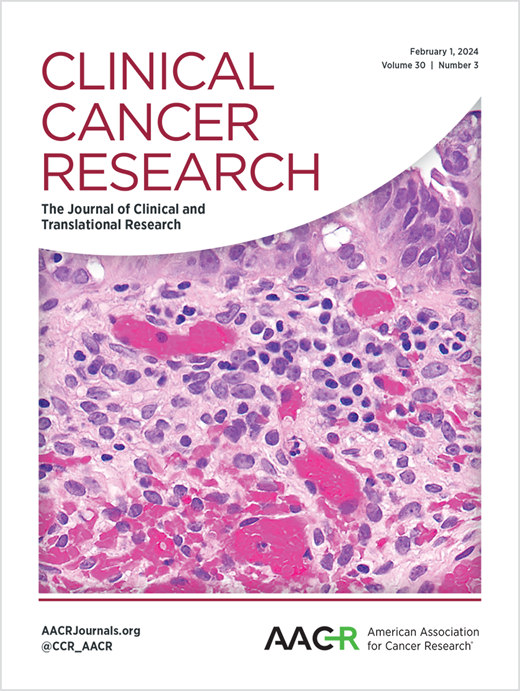转移龛内伤口愈合程序的异常激活有助于骨肉瘤细胞在肺部定植
IF 10
1区 医学
Q1 ONCOLOGY
引用次数: 0
摘要
目的:肺转移是造成骨肉瘤死亡的主要原因。恶性骨细胞如何胁迫肺部微环境以支持转移生长仍不清楚。我们试图通过阐明肺部转移龛形成所必需的细胞和分子机制,找出转移特异性治疗漏洞。实验设计:我们使用单细胞转录组学(scRNA-seq)来描述扩散的骨肉瘤细胞在肺组织内诱导的分子变化。然后,我们评估了宁替尼在免疫功能健全小鼠和免疫缺陷异种移植模型中逆转转移特异性变化的能力。分子药效学研究使用单核和空间转录组学来确定药物诱导的肿瘤内在和外在变化。研究结果scRNA-seq表明,周围的肺基质采用了一种慢性、非溶解性伤口愈合表型,类似于与肺损伤相关的疾病。因此,转移相关的肺部表现出明显的纤维化,这可能是由于致病性、促纤维化、部分分化的上皮中间产物和巨噬细胞的积累。我们的数据表明,宁替达尼通过抑制骨肉瘤诱导的纤维化,阻止了多种小鼠和人类异种移植模型的转移进展。结论纤维化对骨肉瘤肺转移至关重要,是一种可靶向的脆弱性。我们的数据支持这样一种模型:骨肉瘤与上皮细胞之间的相互作用会诱导细胞外基质蛋白的沉积--抗纤维化 TKI nintedanib 会破坏这种反应。我们的数据揭示了TKIs对转移的非细胞自主效应,并为利用单细胞和空间转录组学确定TKIs在动物模型中对转移的作用机制提供了路线图。本文章由计算机程序翻译,如有差异,请以英文原文为准。
Aberrant activation of wound healing programs within the metastatic niche facilitates lung colonization by osteosarcoma cells
Purpose: Lung metastasis is responsible for most deaths caused by osteosarcoma. How malignant bone cells coerce the lung microenvironment to support metastatic growth remains unclear. We sought to identify metastasis-specific therapeutic vulnerabilities by delineating the cellular and molecular mechanisms essential to metastatic niche formation in the lung. Experimental design: We used single-cell transcriptomics (scRNA-seq) to characterize molecular changes induced within lung tissues by disseminated osteosarcoma cells. We then evaluated the ability of nintedanib to reverse metastasis-specific changes in both immunocompetent mouse and immunodeficient xenograft models. Molecular pharmacodynamic studies used single-nucleus and spatial transcriptomics to define the tumor-intrinsic and -extrinsic changes induced by the drug. Results: Osteosarcoma cells induced acute alveolar epithelial injury upon lung dissemination. scRNA-seq demonstrated that the surrounding lung stroma adopts a chronic, non-resolving wound-healing phenotype similar to diseases associated with lung injury. Accordingly, metastasis-associated lung demonstrated marked fibrosis, likely due to the accumulation of pathogenic, pro-fibrotic, partially differentiated epithelial intermediates and macrophages. Our data suggested that nintedanib prevented metastatic progression in multiple murine and human xenograft models by inhibiting osteosarcoma-induced fibrosis. Conclusions: Fibrosis is essential to osteosarcoma lung metastasis and represents a targetable vulnerability. Our data support a model where interactions between osteosarcoma and epithelial cells induce the deposition of extracellular matrix proteins—a reaction disrupted by the anti-fibrotic TKI nintedanib. Our data shed light on the non-cell autonomous effects of TKIs on metastasis and provide a roadmap for using single-cell and spatial transcriptomics to define the mechanism of action of TKIs on metastases in animal models.
求助全文
通过发布文献求助,成功后即可免费获取论文全文。
去求助
来源期刊

Clinical Cancer Research
医学-肿瘤学
CiteScore
20.10
自引率
1.70%
发文量
1207
审稿时长
2.1 months
期刊介绍:
Clinical Cancer Research is a journal focusing on groundbreaking research in cancer, specifically in the areas where the laboratory and the clinic intersect. Our primary interest lies in clinical trials that investigate novel treatments, accompanied by research on pharmacology, molecular alterations, and biomarkers that can predict response or resistance to these treatments. Furthermore, we prioritize laboratory and animal studies that explore new drugs and targeted agents with the potential to advance to clinical trials. We also encourage research on targetable mechanisms of cancer development, progression, and metastasis.
 求助内容:
求助内容: 应助结果提醒方式:
应助结果提醒方式:


